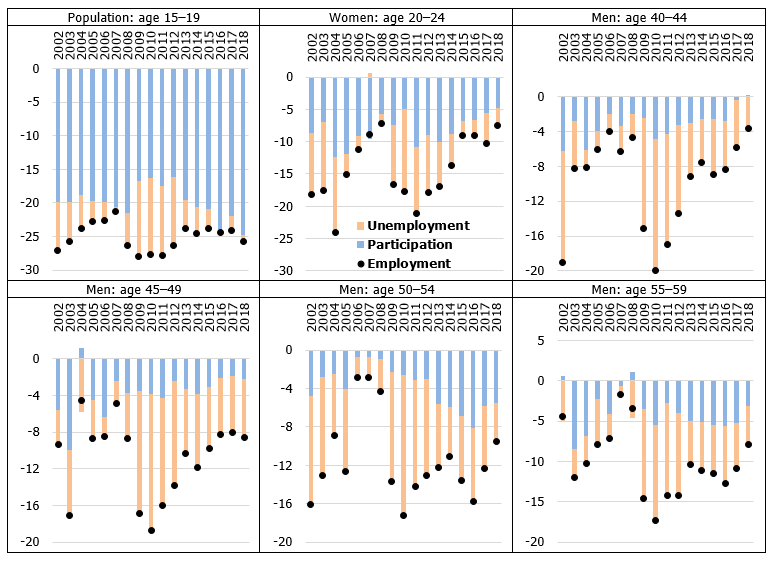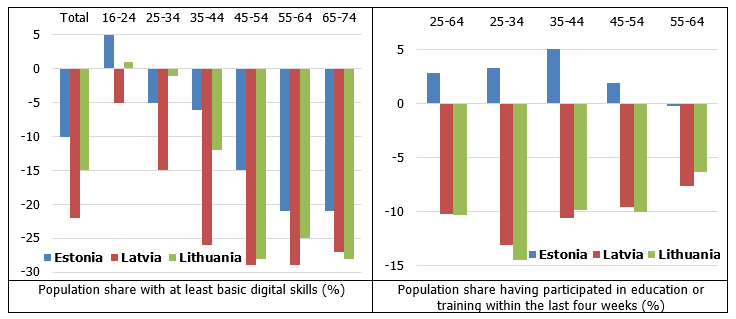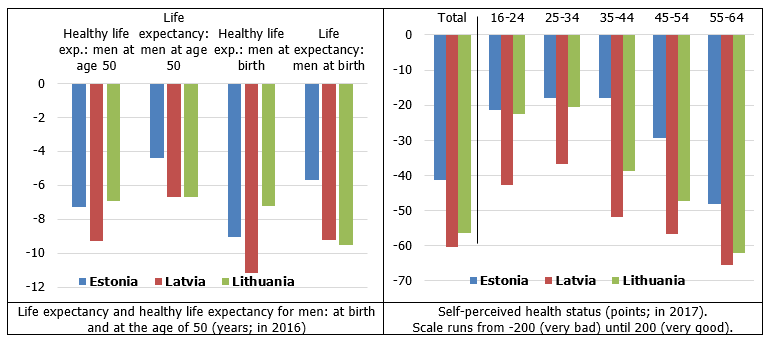Why are Baltic labour reserves far from exhausted?

The Baltic labour market is becoming more favourable to employees, wages are growing faster than productivity, and businesses are increasingly claiming that their expansion is dampened by a shortage of labour. Does this mean that the chronic shortage of jobs (which was characteristic of the Baltic countries in the first twenty years after the restoration of their independence) has been cured or is it a temporary remission reflecting a cyclical upturn in the economy?
Although many aggregate labour market indicators (e.g. unemployment, employment rate, etc.) look decent compared to those of many other European Union (EU) countries, the actual labour market situation in the Baltics differs significantly across population groups and regions. Labour shortages in some occupations and regions often coexist with underemployment elsewhere, which means that labour reserves in the Baltic countries are not exhausted. This article quantifies the available labour reserves, identifies the population groups that should receive particular attention from policy makers, and outlines the key policies for activating labour reserves.
1. How big are the internal labour reserves in the Baltic countries?
Currently, the internal labour reserves exceed 25 thousand people in Estonia, 55 thousand in Latvia and 85 thousand in Lithuania, which corresponds to 4%–7% of the total employment in these countries. Such considerable additional employment would fuel the economy if all gender and age groups with low employment rates saw their employment levels rise to those recorded by the EU benchmark countries (hereafter, referred to as the EU7[1]). However, not all of these people are currently actively seeking a job: some of them are economically inactive but are either available for work or may become available after improving their professional skills or health condition or following improvements in the labour market regulation.
The employment rate is particularly low for upper-middle-aged men. The employment rate of men aged 45 to 59 is by almost 10 percentage points (pp) lower in Latvia and Lithuania than in the EU7 (Chart 1). Low employment rates are particularly prevalent for upper-middle-aged men without higher education. For example, the employment rates of men with basic education in the age groups 55–59 and 45–54 in Latvia and Lithuania respectively are the lowest in the EU (Table 1). In addition, men with higher education in the upper-middle age group also show a modest level of employment. Low employment rate of upper-middle-aged men is also a characteristic of Estonia, but this trend is more pronounced in Latvia and Lithuania.
Youth employment is also relatively low: the employment rate of young people aged 15–19 in all three Baltic countries is lagging behind that in the EU7 by about 20–25 pp, mainly reflecting the very low participation of the respective age group in the labour market; this difference is very similar among young men and women. It should be noted that youth employment remains at a consistently low level irrespective of the economic cyclical conditions. Thus, it likely reflects fundamental issues such as a low prevalence of apprenticeships (rather than low labour demand) in the Baltics. Lithuania and Latvia are also characterized by delayed entry of young women (aged 20–24) into the labour market. In Estonia, employment of women in childbearing age (25–44) with a tertiary education degree is low.
Chart 1. Employment rate in Latvia compared to that in the EU7 (by population group; percentage points; contribution)

Table 1. Ranking of the Baltic countries by employment level (ranking among 28 EU countries; by detailed population group; averages over 2016–2018)

Notes: A number represents the country's ranking among 28 EU countries. Number "1" refers to the highest employment rate in the EU in the respective population group, while number "28" refers to the lowest employment rate correspondingly.
2. How to activate internal labour reserves?
Factors contributing to low employment rates of upper-middle-aged men include a low incidence of lifelong learning, inadequate digital skills and rapid deterioration in health. With respect to all the above indicators, Estonia is well ahead of Latvia and Lithuania. Therefore, it is not surprising that the low employment rate of upper-middle-aged men in Estonia is not as pronounced as in the other two Baltic countries.
In terms of lifelong learning, Latvia and Lithuania are lagging behind the EU7 and Estonia in all age groups. For example, in Latvia and Lithuania only 3% of men aged 45–54 reported having participated in education or training in the last four weeks, compared to 12% in Estonia and the EU7. The situation is similar with regard to the digital skills of middle-aged people. For example, in the EU7 almost three quarters of individuals aged 45–54 have at least basic digital skills, with Estonia, Lithuania and Latvia lagging behind by 15 pp, 28 pp and 29 pp respectively (Chart 2).
Many middle-aged men in the Baltics also have inadequate health conditions by the EU standards: a high proportion of individuals regard their health as bad or very bad, in Latvia and Lithuania in particular (Chart 3). Healthy life expectancy is also unacceptably low; for example, a typical 50-year-old man in Latvia would live in good health for another 11 years, almost twice less than in the EU7. Inadequate health status is likely the result of both low healthcare spending and low healthcare system efficiency. The high share of private spending in the healthcare expenditure structure further reduces accessibility to healthcare services, especially for low-income households. In addition, unhealthy lifestyle involving heavy tobacco and alcohol consumption and insufficient physical activity also negatively affect the health of the Baltic population. For example, the share of smokers among young men in Estonia, Lithuania and Latvia notably exceeds that in the EU7 (by approximately 10 pp, 15 pp and 20 pp respectively); moreover, irrespective of their income level, men in the Baltic countries exercise significantly less than their counterparts in the EU7.
One might naively argue that the problem of low employment of upper-middle-aged men will resolve itself with the change of generations. However, this is unlikely to be the case. Differences in the quality of education and health between the Baltics and the EU7 appear much earlier than in the middle age. For example, adolescents in the Baltics are already significantly less healthy than their peers in the EU7. The quality of education in the EU7 and Estonia is also significantly higher than that in Latvia and Lithuania, as evidenced by international standardised tests (e.g., PISA) and university rating platforms (e.g., QS), as well as business expert views on whether the skills of graduates match labour market needs. This suggests that internal labour reserves will never be activated without a significant increase in education and health standards.
In addition, special attention in activating internal labour reserves should be paid to ethnic minorities and people living in regions with low economic activity, as labour market performance varies considerably between regions and is substantially worse for ethnic minorities.
Chart 2. Baltic countries vs. EU7: digital skills and lifelong learning by age group (percentage points; difference)

Chart 3. Baltic countries vs. EU7: life expectancy and self-perceived health status

3. How big are external labour reserves available to the Baltic countries?
Labour reserves in the Baltic countries are not limited to internal reserves. Since the beginning of the century, the Baltics have experienced two waves of emigration (at the time of the EU accession and during the economic crisis), with their current diaspora in other EU countries comprising more than half a million adults (about 75 000 from Estonia, over 160 000 from Latvia and over 300 000 from Lithuania) corresponding to 8–13% of the adult population in these countries. Only a small proportion of emigrants plan to return home in the future (Hazans, 2016). Nonetheless, given the large number of emigrants, even modest remigration could have a significant impact on the labour market in the Baltics. In addition, a gradual narrowing of the wage and unemployment gaps between the Baltics and the rich EU countries (or a change in immigration conditions after the Brexit) may increase the propensity to return.
Furthermore, the neighbouring non-EU countries with significantly lower wages may become an important external source of labour reserves for the Baltic countries. In many neighbouring regions, such as those of Ukraine, Russia and Belarus, the average wage is below the minimum wage in the Baltics. For example, the current wage gap between the Baltics and Ukraine is similar to that observed between the Baltics and the UK 15 years ago when it led to significant migration flows. Therefore, it is clear that immigration from the non-EU countries would be significantly higher if not restricted by the EU border and the legislation of the Baltic countries. Thus, gradual simplification of immigration legislation during the periods of cyclical expansion and introduction of stricter immigration conditions during economic downturns could become useful tools in the hands of the Baltic policymakers when facing large mismatches between labour market supply and demand and an urgent need for corrections (activation of both internal labour reserves and remigrants is likely to take a longer time).
However, it should be noted that only highly qualified immigrants are able to increase GDP per capita and thus contribute to the income convergence of Latvia, Estonia and Lithuania with the rest of the EU. Low-skilled immigration, on the contrary, tends to reduce the average standard of living in a country. An additional argument against the mass influx of low-skilled workers is that the employment rate of those without a tertiary education degree in the Baltics is significantly lower than that in the EU7.
Conclusions
The myth of almost exhausted labour reserves in the Baltic countries may arise from the comparison of aggregate labour market indicators (such as unemployment or employment rates) over time or with the EU average. This superficial comparison does not take into account the fact that the employment of some population groups (e.g., upper-middle-aged men and youth) is still unacceptably low. Currently, the internal labour reserves exceed 25 thousand people in Estonia, 55 thousand in Latvia and 85 thousand in Lithuania, corresponding to 4%–7% of the total employment in these countries. Activating them through a favourable labour market regulation alone will not be enough. It is essential to significantly raise the quality of education and health standards, with a particular focus on ethnic minorities and people living in regions with low economic activity. In addition, the Baltic countries have a significant remigration potential, i.e. over half a million adults who have emigrated to the richest EU countries since the beginning of the century.
The article is based on the discussion paper "Anatomy of labour reserves in the Baltic countries: a snapshot 15 years after the EU accession".
[1] EU7 includes Germany, Austria, Denmark, Netherlands, Sweden, Czech Republic and the UK.
Textual error
«… …»






